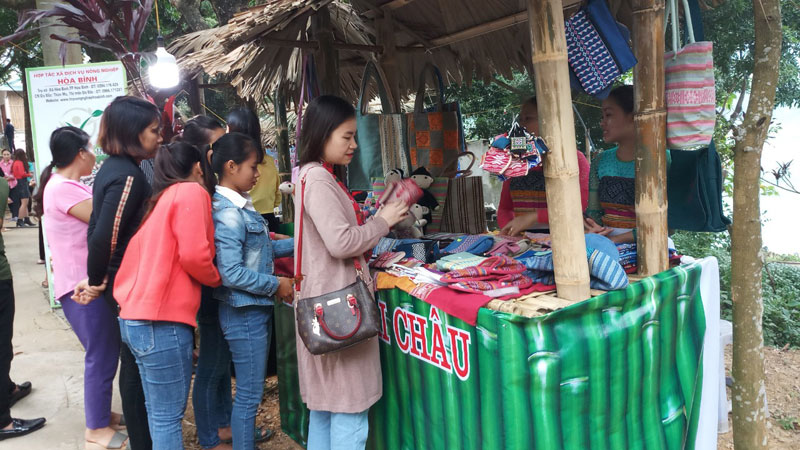
(HBO) - Brocade weaving of Thai ethnic people in Mai Chau district has been in existence for a long time. In the past, women made brocade to mainly serve the daily life of their families, themselves and as the wedding gifts. Nowadays, when tourism develops, the beauty and the cultural traditions of the nation are respected, preserved and promoted, the traditional weaving profession has been strongly restored.
 The products of Chieng Chau Cooperative of Brocade Weaving are
suitable for the taste of women, so they are always paid attention to.
The products of Chieng Chau Cooperative of Brocade Weaving are
suitable for the taste of women, so they are always paid attention to.
Brocade products of Thai ethnic people in Mai Chau in
general and Chieng Chau commune in particular have been on the market, becoming
the popular items for tourists and consumers.
Mrs. Vi Thi Oanh, the Director of Chieng Chau cooperative of
weaving brocade and tourist service says: In 2009, the cooperative was
established with 33 members. With the interest of all levels, appropriate
authorities and the provincial Union of Cooperatives, the members of the
cooperative have been attending the training courses on the transfer of the
technology of making new products and the natural dyeing techniques, marketing
activities, especially participating in trade exhibitions and trade fairs organized
in the province and in other provinces and cities throughout the country.
Thereby, it has been creating conditions for us to capture the market and build
a logo for the product.
At the same time, the cooperative has traded, signed the
contracts of goods supply, found a stable market for consuming products and
directly calculated the plans to invest and buy materials so that the women can
make the weaving brocade products. The Board of Directors has always been
looking for and creating many beautiful designs, which are consistent with the
consumers’ tastes. The outstanding products are woven scarves, tablecloths,
handbags of all kinds, shoes and slippers, diary covers, stuffed animals,
coasters for cups and dishes, seating cushions, pillows, souvenirs and so on.
These products always have a stable consumption market, especially in Japan,
France and some other countries.
The Department of Education and Training of Hoa Binh province held a conference on March 18 to review the performance of the "Safe and Happy School" Project and set out tasks for 2025. The project, funded by the Taiwan Fund for Children and Families (TFCF), aims to create a safe, inclusive, and supportive learning environment for students. The event saw the attendance of representatives from the TFCF and 26 beneficiary schools.
With over 70% of their workers being women, trade unions across industrial parks (IPs) in Hoa Binh have been actively safeguarding their legal rights and interests while implementing initiatives to improve their income and well-being.
In recent years, the Hoa Binh provincial General Hospital has continuously innovated itself and improved the quality of medical services to meet the increasing needs of local people. With substantial investments in infrastructure and modern equipment, along with a team of highly qualified doctors and nurses, the hospital has gradually established itself as one of the leading medical units in the Northwestern region and a trusted destination for healthcare for people inside and outside the province.
From mastering the fundamentals of programming to achieving national recognition, the Programming Club of the Le Van Tam Primary School (STAR LVT28) in Hoa Binh city has made remarkable strides in the field of robotics.
The Ho Chi Minh Communist Youth Union Committee and the Vietnam Youth Federation chapter of Hoa Binh province organised a programme on March 12 to launch the "Digital Literacy" movement and an online quiz on the resolutions of the Vietnam Youth Federation congresses at all levels, as well as the Politburo's Resolution No. 57-NQ/TW on breakthroughs in the development of science, technology, innovation, and national digital transformation.
As climate change grows more unpredictable, the development of production forests has become essential - not just for economic growth, but for safeguarding the environment and maintaining ecosystem balance. By boosting local incomes, curbing natural disasters, preventing soil erosion, and protecting water resources, these forests play a crucial role in sustainable development.



 The products of Chieng Chau Cooperative of Brocade Weaving are
suitable for the taste of women, so they are always paid attention to.
The products of Chieng Chau Cooperative of Brocade Weaving are
suitable for the taste of women, so they are always paid attention to.